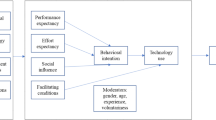conclusion
The Information Age has revolutionized the workplace. While it is possible to purchase or copy machines and technology, their very interchangeability means they fail to cre-ate a sustained competitive advantage for an organization (Barney, 1991). The research directions this paper offers are intended to develop firm knowledge that allows creation of inimitable human resources. Importantly, in the rush to embrace new information technologies, organizations must remember the fundamental principle that workers will invest in firm goals in the presence of shared values and a commitment by the firm to make their well-being a priority. We urge continued attention to fulfillment of the psy-chological contract, and to the "people issues" that frequently seem less critical than issues of hardware or technology.
Similar content being viewed by others
References
Anfuso, Dawn. “Experts Recommend Team-Based Incentives and Stipends for Telecommuters.” Personnel Journal 74 (January 1995): 119.
Barney, Jay. “Firm Resources and Sustained Competitive Advantage.” Journal of Management 17 (March 1991): 99–120.
Black, J. Stuart, Mark Mendenhall, and Gary Oddou. “Toward a Comprehensive Model of International Adjustment: An Integration of Multiple Theoretical Perspectives.” Academy of Management Review 16 (April 1991): 291–317.
Cardy, Robert L. “Future-Oriented and Organizational-Level Approaches to Job Analysis.” In K.P. Carson (Chair) Future Directions in Job Analysis. Symposium presented at the Annual Conference of the Society for Industrial and Organizational Psychology, San Francisco (April 1993).
—and Gregory Dobbins. Performance Appraisal: Alternative Perspectives. Cincinnati: Southwestern Publishing, 1994.
Carson, Kenneth P. and Greg L. Stewart. “Job Analysis and the Sociotechnical Approach to Quality: A Critical Examination.” Journal of Quality Management 1 (August 1996): 49–65.
Chatman, Jennifer A. “Matching People and Organizations: Selection and Socialization in Public Accounting Firms.” Administrative Science Quarterly 36 (September 1991): 459–84.
Cooper, Cecily, Nancy B. Kurland, and Diane E. Bailey. “Telecommuting: Manager Control and Employee Development in One Public and Two Private Organizations.” Paper presented at the Annual Meeting of the Academy of Management, Chicago (1999).
Dreher, George F. and Taylor H. Cox, Jr. “Race, Gender, and Opportunity: A Study of Compensation Attainment and the Establishment of Mentoring Relationships.” Journal of Applied Psychology 81 (June 1996): 297–308.
Fegenson, E. A. “The Mentor Advantage: Perceived Career/Job Experiences of Protégés vs, Nonprotégés.” Journal of Organizational Behavior 10 (October 1989): 309–20.
Flannery, Thomas P., David A. Hofrichter, and Paul E. Platten. People, Performance, and Pay. New York: Free Press, 1996.
Greengard, Samuel. “Making the Virtual Office a Reality.” Personnel Journal 73(September 1994): 66–79.
Gregersen, Hal B. and J. Stewart Black. “Antecedents to Commitment to a Parent Company and a Foreign Operation.” Academy of Management Journal 35 (February 1992): 65–90.
Guimaraes, Tor and Magid Igbaria. “Client/Server System Success: Exploring the Human Side.” Decision Sciences 28 (Fall 1997): 851–75.
Hamilton, Carol-Ann. “Telecommuting.” Personnel Journal 66 (April 1987): 91–101.
Hill, E. Jeffrey, Brent C. Miller, Sara P. Weiner, and Joe Colihan. “Influences of the Virtual Office on Aspects of Work/Life Balance.” Personnel Psychology 51 (Autumn 1998): 667–83.
Huselid, Mark. “The Impact of Human Resource Management Practices on Turnover, Productivity, and Corporate Financial Performance.” Academy of Management Journal 38 (June 1995): 635–72.
Irving, R. H., C. A. Higgins, and R. R. Safayeni. “Computerized Performance Monitoring Systems: Use and Abuse.” Communications of the ACM 29 (August 1986): 794–801.
Katz, Daniel and Robert L. Kahn. The Social Psychology of Organizations. New York: John Wiley, 1978.
Kerr, Steven. “On the Folly of Rewarding A., While Hoping for B.” Academy of Management Journal 18 (December 1975): 769–82.
Kraut, Robert, Susan Dumais, and Susan Koch. “Computerization, Productivity, and Quality of Work Life.” Communications of the ACM 32 (February 1989): 220–38.
O'Reilly, Charles A., Jennifer Chatman, and D. F. Caldwell. “People and Organizational Culture: A Profile- Comparison Approach to Assessing Person-Organization Fit.” Academy of Management Journal 34 (September 1991): 485–516.
Perry, Nancy J. “The Workers of the Future.” Fortune (Special Issue, Spring-Summer 1991): 68–72.
Robey, Daniel. “User Attitudes and Management Information System Use.” Academy of Management Journal 22 (June 1979): 527–38.
Robinson, Sandra L. “Trust and Breach of the Psychological Contract.” Administrative Science Quarterly 41 (December 1996): 574–99.
Scandura, Terri. “Mentorship and Career Mobility: An Empirical Investigation.” Journal of Organizational Behavior 13 (March 1992): 169–74.
Shamir, Boas and Ilan Salomon. “Work-at-Home and the Quality of Working Life.” Academy of Management Review 10 (July 1985): 455–64.
Snell, Scott A. and James W. Dean, Jr. “Integrated Manufacturing and Human Resource Management: A Human Capital Perspective.” Academy of Management Journal 35 (June 1992): 467–504.
Stumpf, Stephen A., and Manuel London. “Management Promotions: Individual and Organizational Factors Affecting the Decision Process.” Academy of Management Review 6 (October 1981): 539–50.
Tomaskovic-Devey, Donald and Barbara J. Risman. “Telecommuting Innovation and Organization: A Contingency Theory of Labor Process Change.” Social Science Quarterly 74 (June 1993): 367–85.
Townsend, Anthony M., Samuel M. DeMarie, and Anthony R. Hendrickson. “Virtual Teams: Technology and the Workplace of the Future.” Academy of Management Executive 12 (August 1998): 17–29.
Walton, Richard E. and Gerald I. Susman. “People Policies for the New Machines.” Harvard Business Review 65 (March-April 1987): 98–106.
Warkentin, Merril E., Lutfus Sayeed, and Ross Hightower. “Virtual Teams Versus Face-to-Face Teams: An Exploratory Study of a Web-Based Conference System.” Decision Sciences 28 (Fall 1997): 975–96.
Williams, Kevin J. and George M. Alliger. “Role Stressors, Mood Spillover, and Perceptions of Work-Family Conflict in Employed Parents.” Academy of Management Journal 37 (August 1994): 837–68.
Zeleny, Milan. “Telework, Telecommuting and Telebusiness.” Human Systems Management 17 (1998): 223–25.
Author information
Authors and Affiliations
Rights and permissions
About this article
Cite this article
Miller, J.S., Cardy, R.L. Technology and managing people:. J Labor Res 21, 447–461 (2000). https://doi.org/10.1007/s12122-000-1020-5
Issue Date:
DOI: https://doi.org/10.1007/s12122-000-1020-5




